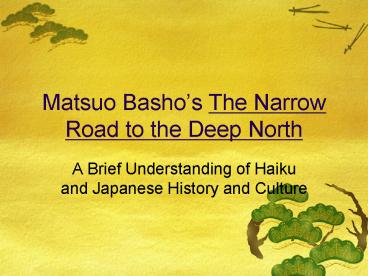Matsuo Basho - PowerPoint PPT Presentation
1 / 19
Title:
Matsuo Basho
Description:
Matsuo Basho s The Narrow Road to the Deep North A Brief Understanding of Haiku and Japanese History and Culture What is Haiku? a Japanese poem of seventeen ... – PowerPoint PPT presentation
Number of Views:718
Avg rating:3.0/5.0
Title: Matsuo Basho
1
Matsuo Bashos The Narrow Road to the Deep North
- A Brief Understanding of Haiku and Japanese
History and Culture
2
What is Haiku?
- a Japanese poem of seventeen syllables, in three
lines of five, seven, and five, traditionally
evoking images of the natural world. - (This should probably go on your vocab list)
3
Example
- Furuike ya
- kawazu tobikomu
- mizu no oto
- Breaking the Silence
- Of an ancient pond
- A frog jumped into water-
- A deep resonance
4
Remember
- Japanese and English are two very different
languages - The English translations of the poems will not
always follow the syllable structure of 5-7-5 - When you read the Japanese versions the trick to
pronunciation is to say each and every letters
sound
5
A bit o history
- Basho lived from 1644-1694 during the Edo Period,
also known as the Tokugawa period
6
Periods of Japanese History
- Jomon Period through 300 B.C.
- Yayoi Period 300B.C.-300AD
- Kofun or Yamato Period 300-680
- Asuka Period 645-710
- Nara Period 794-1185
- Heian Period 794-1185
- Kamakura Period 1185-1333
- Ashikaga Bakufu 1336-1467
- Era of Warring states 1467-1600
- The Tokugawa Shogunate and the Edo Period
1600-1868 - Meiji Restoration Period 1868-1912
- Modern Japan
7
The Warring States Era
- The Warring States Era was a time of sustained
internal struggle among many groups. Violence and
anarchy were especially prevalent
8
The Edo Period
- The Edo era brought the establishment of a rigid
social hierarchy and Tokyo as a leading city in
Japan. - The industrial age of the rest of the world is
quickly catching up and invading Japan's
isolationism. - This is also an era of great culture and society.
9
Tokugawa Shogunate
- Life in Tokugawa Japan was strictly hierarchical
with the population divided among four distinct
classes samurai, farmers, craftspeople, and
traders. - Prior to the Tokugawa period there was some
movement among these classes, but the Tokugawa
shoguns, intent upon maintaining their power and
privilege, restricted this movement.
10
Samurai
11
Samurai
- The samurai were the warrior class.
- At the top was the shogun.
- Beneath him were the daimyo, local lords who
controlled large amounts of land. - In addition, samurai in the large cities such as
Edo might fulfill a variety of functions--as
officials in the Shogun's government or as
policemen. - Of the approximately 30 million Japanese during
the Tokugawa period, about 2 million were samurai.
12
Ronin
- Ronin were "masterless" samurai, without a lord
to answer to, but also without any definite means
of support. - Many of them wandered the countryside, looking
for gainful employment. Some sold their services
as hired warriors to the highest daimyo bidder.
Of the approximately 30 million Japanese during
the Tokugawa period, about 2 million were
samurai.
13
Farmers
14
Farmers
15
(No Transcript)
16
(No Transcript)
17
(No Transcript)
18
(No Transcript)
19
(No Transcript)































